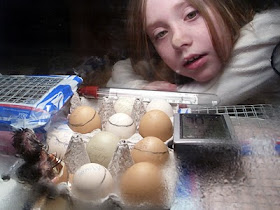Hard to believe I have made it this long without a post dedicated to Black Javas. You wouldn't even know they are my first priority, judging by their meager appearance here. They aren't the flashiest--no blue eggs here, no chocolate browns either, and certainly no olives...but they are a kind of "meat and potatoes" bird for someone who truly wants a sustainable backyard flock. See
an album of most of my Black Javas here.
 |
| Malcolm with the laying flock (non-Black Java hens are shown) |
One of the first two American breeds, Black Javas were extremely popular among homesteaders and pioneers of the 1800s due to several factors still found in the birds today. First, they are a great dual-purpose breed: a good balance between a body size big enough to make a decent family meal, but not so large as to reduce by a great deal the egg output (the slimmest birds lay the most eggs--think Brown Leghorns--but aren't great fare for the table).

Next, they are excellent foragers. Allowed access to grass, leaves, and other vegetation, they will choose to forage for much of the day, rather than hanging around the feed bin, waiting to be fed. This means that those who keep Black Javas consistently report that the breed consumes less store-bought feed than their other birds. My Black Javas have been particularly vigilant at being the first to sound predator-alarms to the greater flock of several breeds, when hawks, foxes, or dogs are sighted during foraging, meaning I feel more comfortable letting them have wider access to free-ranging areas.

For those interested in maintaining a flock without needing to replenish with new chicks on an ongong basis, Black Javas offer a great option--hens often "go broody" (see my post on what this means), set eggs, hatch eggs effectively, and then make great mothers. My best broody is a Black Java named Minerva, and I've posted many a video and picture of her on this blog. She's an inspiring mother, and a credit to her breed, but other breeders report similar experiences.

Finally, Black Javas have a great personality--calm, somewhat aloof, and disinterested in conflict with other birds, as a rule. They stick together better than any of my birds, and roosters are most often gentlemanly and protective. I have a whole post on the merits of Malcolm, my BJ chief, in fact. Good roosters have a near-holiness about them that is hard to explain if you've never had the pleasure of being around one, or if your thoughts about roosters were formed from a traumatic experience with a bad roo.
So, if they're so great, why are they endangered? Would you believe that corporate food production is the answer? A kind of chicken breed "monoculture" sprang up, with the industry focusing on just a handful of breeds to the exclusion of all others. Yet BJs were extremely important in the development of those breeds. Wikipedia says, "The Java is a key foundation breed for the American class of chickens,
[4] having contributed significantly to major modern fowl such as the
Jersey Giant,
Rhode Island Red and
Plymouth Rock.
[3] They are also likely to be the source of the yellow skin in contemporary Dominiques, which once had white skin.
[4]"
I'm proud to be maintaining a small breeding flock, keeping records, and getting birds out to folks as often as possible. The Black Javas are nearly gone.
 |
| Yellow feet are required for showing BJs. |
Again, from Wikipedia: "Beginning in the 1990s, breeders and conservation organizations began
to make a more concerted effort to save the Java. In particular, the
Garfield Farm Museum in
Illinois has played a pivotal role in the preservation of Javas in the 21st century.
[8] Beginning with Mottled and Black Javas,
sports from the Garfield flock have revived the White variety.
[9] The Garfield Farm was also been supported by the
Museum of Science and Industry in
Chicago, which hatched Java chicks as part of their exhibit on
genetics.
[6] The
American Livestock Breeds Conservancy
continues to list Javas as Critical on its watchlist, meaning fewer
than 500 breeding birds from five or fewer primary breeding flocks are
known (this does not take in to account the population of non-breeding
flocks).
[5] The breed is also listed as part of
Slow Food USA's
Ark of Taste, a catalog of heritage foods in danger of extinction.
[10]".
If you are looking for a stable, hardy, sustainable backyard flock, consider Black Javas. I will have hatching eggs available to ship all over the United States come Spring, and day old chicks for sale locally (only).
 |
| Black Javas foraging |
|
















